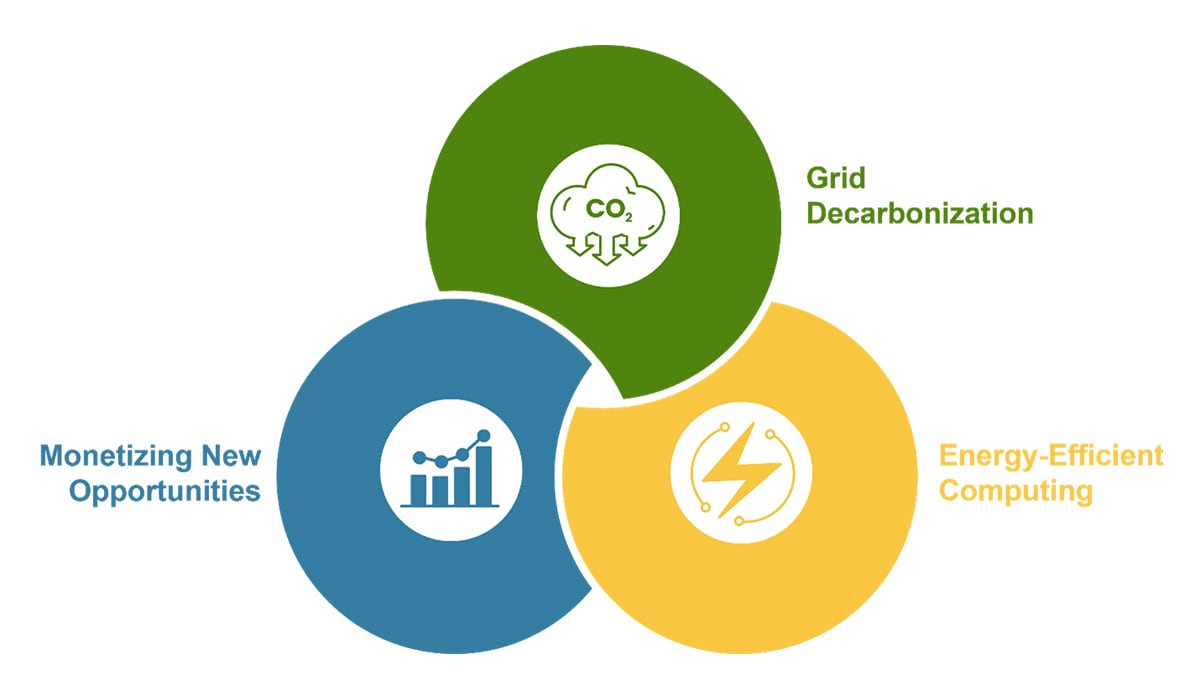Products & Technologies
Products & Technologies
Services
Resources
Sustainable Energy Abundance for AI
Strategic Imperative
Artificial Intelligence (AI) driven by advanced semiconductor technologies offers the single greatest lever to counteract slowing workforce growth and mounting sovereign debt in the world’s largest economies. By boosting productivity at scale, AI can arrest declines in standards of living, shape equitable income distribution, and bolster political stability. Building the “computing superstructure” to support this ambition, however, will profoundly reshape global energy demand.
The incremental electricity demand burden will be so great that simply bolting on new streams of clean (or carbon-free) energy production or greatly expanding legacy sources will be insufficient and inefficient. The grid itself must be restructured with a holistic approach for sustainable abundant energy. A narrow focus on a subset of variables like emissions or “green” energy risks the creation of an unnecessarily fragile system. Scale-out of advanced computing infrastructure and the ability to cost-effectively and sustainably generate abundant supply are both vitally important to address macroeconomic, geopolitical, and climate risks.
This report outlines a new playbook to accelerate provisioning of sustainable abundant energy for AI through: (a) grid decarbonization, (b) energy-efficient computing, and (c) monetizing new opportunities for semiconductors. Grid decarbonization requires (i) more energy generation, (ii) grid modernization and scale-out, and (iii) mix shift to clean sources. Energy-efficient computing requires (i) a new playbook to optimize computing architecture, design, and manufacturing; (ii) fab solutions to raise efficiency and abatement; and (iii) fabs located where clean (or carbon-free) energy is abundant. Monetizing new opportunities for semiconductors requires a new collaboration model across the industry to enable high-velocity co-innovation.
This report presents a holistic strategy that realigns sustainability and decarbonization with energy abundance, ensuring AI’s productivity gains are not sidelined by grid constraints.
A New Playbook for Sustainable Energy Abundance
Our proposed new playbook for accelerating provisioning of sustainable abundant energy for AI is composed of three pillars: (a) grid decarbonization, (b) energy efficient computing, and (c) monetizing new opportunities for semiconductors.
Consuming electricity from the grid assumes the emissions profile of the grid itself. It should come as no surprise that emissions related to the grid represent the single biggest component of the emissions bill facing any given company. Still, in the conventional approach to sustainability, companies focused more on offsetting emissions derived from the grid rather than sourcing the grid with cleaner energy. Our new playbook prioritizes clean (or carbon-free) energy grid infrastructure for accelerating AI.

New Playbook – Sustainable Energy Abundance for AI. Source: Applied Materials SMI.
Acknowledgements
We would like to thank all our internal and external authors and partners for their guidance, insight and support for the development of this report.
Applied Materials
Sundeep Bajikar
Aashiv Shah
Dean Ramos
Kostas Mallios
Chris Librie
Elena Kocherovsky
Nasreen Chopra
David Britz
Om Nalamasu
Tristan Holtam
Partners
Dallal Slimani (Schneider Electric)
Rajiv Khemani (Auradine)
Alexander Landia (The Mobility House)
Junichiro Yaguchi (Kioxia)
Carrie MacGillivray (TechInsights)
Pravin D’souza (Tata Electronics)
Elizabeth Elroy (Micron)
Marshall Chase (Micron)
Brian Daigle (Micron)
Neil Shah (Counterpoint)
Herve Maury (STMicroelectronics)
James Connaughton (JLC Strategies)
Andy Karsner (Stanford University Precourt Institute)
Peter Colohan (Lincoln Institute)
Yannis Tsakiris (European Investment Bank)
Handel Jones (IBS)
Related Content

Delivering Sustainable Energy Abundance for the AI Era
